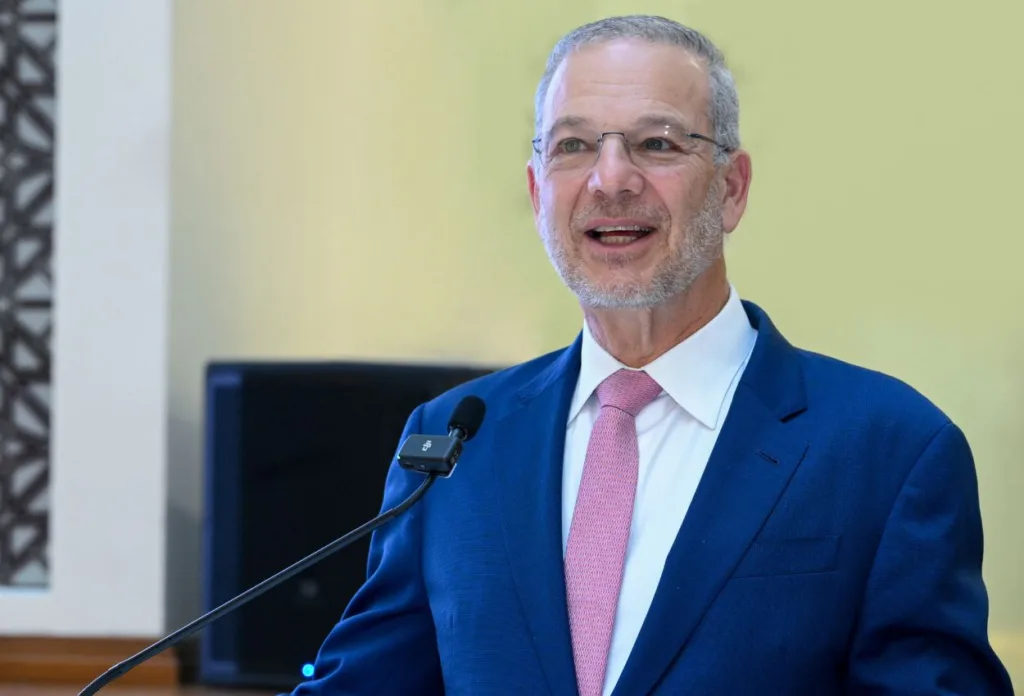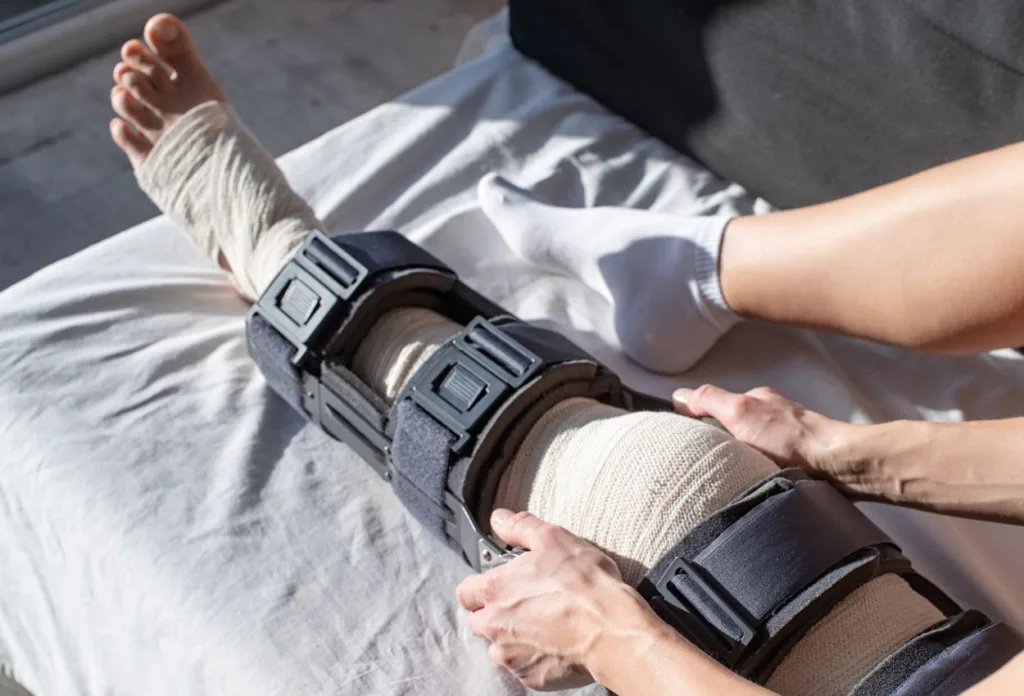More men in the UAE are undergoing limb lengthening surgery, a complex procedure once reserved for correcting medical deformities but now increasingly sought for cosmetic reasons.
“Limb lengthening surgery was originally designed to correct leg length discrepancies, where one limb is shorter than the other,” Dr. Dror Paley, CEO & Founder, Consultant Orthopaedic Surgeon, Paley Middle East Clinic told Lana in an exclusive interview.
The principle of the procedure is based on the body’s natural ability to form new bone when broken, Dr. Paley said.
How limb lengthening works

“During the procedure, we carefully break the bone and then gradually pull the two ends apart, about one millimetre per day. As the gap widens, the body fills it in with new bone,” he explained.
The separation is achieved through an external fixator – a frame fixed to the bone through the skin – or an internal implant known as a nail. The gradual process allows bone, muscle and nerve to adapt without injury.
However, today, what began as a medical solution for children and adults with uneven limbs or congenital defects has become a growing field of elective enhancement.

“The demand for limb lengthening procedures has skyrocketed in recent years. While they remain essential for patients with genuine medical conditions such as congenital discrepancies or deformities, we are also seeing a marked increase in individuals seeking the surgery for cosmetic reasons,” Dr. Paley explained.
Both medical and aesthetic requests have increased “significantly,” but it is the latter that now dominates.
Many of the new patients are otherwise healthy adults seeking to modify their stature rather than to treat a disability.
According to Dr. Paley, “the majority of patients seeking aesthetic limb lengthening are men – about two-thirds, compared to one-third women.” His clinic has operated on individuals aged between 15 and 65.
However, “for many, it is a body-image concern,” he said.
So, why are more men in the UAE choosing limb lengthening surgeries?

In 2025, a review of 12 international studies covering 760 patients found that men make up nearly two-thirds (67 per cent) of those choosing cosmetic limb lengthening, with an average age of around 25 years.
“Almost all patients who come for cosmetic lengthening express the same underlying feeling: they believe they are too short.”
Echoing the sentiment, Dr. Alexandre Machado, Clinical Neuropsychologist at Hakkini, said that men often seek the operation “due to inferiority complexes or a desire to meet societal norms.”
“While it may be understandable for those with extreme short stature seeking a ‘normal’ height,” he said, “others motivated by a wish to appear ‘powerful’ misunderstand that true stature stems from character, ethics, and confidence, not physical height.”
He said dissatisfaction with height is often linked to insecurity and cultural messaging. In many cultures, height is associated with authority and attractiveness.
“In cultures where height correlates with status, men from shorter-average populations may internalise inferiority,” Dr Machado said.
“Globalised beauty standards amplify this, conflating height with leadership or attractiveness. When height becomes a disproportionate focus, it can distort self-perception and drive extreme choices.”
In addition, Dr. Machado explained, that the “dissatisfaction” in one’s height can worsen if driven by “aesthetic fixation or insecurity.”

“For individuals with severe height-related functional challenges, surgery might alleviate distress. However, in cases driven by aesthetic fixation or insecurity, it risks worsening body dysmorphia or creating new insecurities such as scarring or gait changes,” he said.
From a medical perspective, Dr. Paley explained that many surgeons distinguish between clinical need and personal desire.
“We differentiate between those who require surgery for a clear clinical condition, such as dwarfism or leg length discrepancy, and those whose motivations are purely aesthetic,” Dr. Paley said, adding that while both conditions can be addressed, they often make sure patients understand the after-effects and responsibilities involved.
Dr Machado also called for mandatory psychological assessment before surgery.“
Mandatory psychological evaluations should assess motives, screen for disorders (BDD, narcissism), and test for maladaptive traits,” he said.
Tools such as the MMPI-2 and the Body Dysmorphic Disorder Questionnaire help identify whether the motivation stems from low self-esteem rather than medical need.
UAE emerges as limb lengthening treatment hub

Nevertheless, Dr. Paley revealed that the UAE has become an “emerging” treatment hub for limb lengthening procedure, combining specialist expertise with lower costs than many Western markets.
“The UAE is definitely emerging as a destination for these procedures,” Dr. Paley said. “Our Paley Middle East Clinic is part of the global Paley Institute family, with centres on four continents. Much of our work here focuses on reconstructing children with congenital leg-length discrepancies and birth defects. At the same time, we also see a significant demand for stature lengthening, both in cases of severe short stature due to conditions like dwarfism and in purely cosmetic cases.”
However, according to Dr. Machado, attitudes are evolving in the UAE. “While self-care is encouraged, elective surgeries like limb lengthening may still carry subtle stigma if perceived as vanity. Open dialogue about mental-health motivations is essential to distinguish genuine need from impulsive alteration.”
Yet, there are still many factors to consider before undergoing a limb lengthening surgery.
Limb lengthening surgery in the UAE: Cost, procedure, recovery time, risks explained

In the United States, the cost of cosmetic limb lengthening ranges between $100,000 and $110,000, he explained, adding that in the UAE, “the costs are lower.”
“[Lower procedure costs] makes this region an attractive option for patients seeking high-quality care with more affordability,” he said.
“Most patients can expect to gain around eight centimetres in the femurs alone,” Dr. Paley explained.
“Some go further and add another five to eight centimetres in the tibias, making a total gain of up to 16 centimetres.”
Lengthening the femur by eight centimetres requires about three months of active adjustment; the tibia takes about 17 weeks.
Additional months are needed for the bone to consolidate fully. “It’s a significant commitment,” he said, “and patients need to be prepared for both the physical and lifestyle adjustments during the recovery period.”
Moreover, modern techniques rely increasingly on internal devices.
“Today we can lengthen using either external fixators, a combination of nail and external fixator called LON, or internal implantable nails,” Dr Paley explained.
“In our clinic, we prefer the most cutting-edge implantable method because it is more comfortable, discreet, leaves fewer scars, and allows for easier rehabilitation.”
“There are limits to how much lengthening can be done in a single procedure,” he said, “but patients can safely undergo the surgery more than once if needed, provided the bone and soft tissues are healthy.”
Dr Paley also revealed that limb lengthening carries the same risks as any complex orthopaedic operation. Possible complications include delayed bone healing, muscle tightness, nerve irritation, joint stiffness or implant breakage.
“Like any complex surgery, limb lengthening carries potential risks,” he said.
“However, when performed by an extremely experienced surgical team, the likelihood of serious complications is low. We always counsel patients thoroughly about these risks so that they make fully informed decisions before undergoing surgery. Safety is always our number one concern,” he said.
Mental health support essential, says Dr. Machado

In addition, mental-health care must continue through recovery.
“Therapy should focus on fostering self-acceptance and addressing underlying insecurities,” Dr Machado said. “Monitoring for post-surgery dysmorphia, such as fixation on minor imperfections, and integrating cognitive behavioural therapy (CBT) to reframe self-worth beyond physicality are key.”
He recommends Acceptance and Commitment Therapy (ACT) to help patients link self-esteem to personal values rather than appearance.
“Historical figures like Napoleon, who famously said, ‘If I cannot reach, my sword will,’ exemplify transcending physical limits through resilience,” he advised.
Moreover, results depend largely on a patient’s psychological condition before surgery.
“Outcomes depend on pre-operative mental health,” Dr Machado said. “Well-adjusted patients with realistic goals may experience confidence gains. Conversely, those with unresolved dysmorphia risk perpetual dissatisfaction, shifting fixation to other ‘flaws’ post-surgery.”
He advocated for a multidisciplinary model combining surgical and psychological assessment. “Require multidisciplinary assessments to evaluate motivations, educate on risks, and explore alternatives,” he said.
“Transparency about recovery pain, financial costs, and potential psychological pitfalls ensures decisions are grounded, not impulsive.”
Demand for limb lengthening surgeries to rise

Limb lengthening now sits at the intersection of medicine, psychology and social behaviour.
A technique created to correct physical disparities has evolved into a procedure that also reflects social aspiration and self-perception. And Dr Paley expects the global market for limb lengthening to expand further.
“We expect demand will continue to grow significantly in the coming decade, both for medical and cosmetic purposes,” he said.
Development will focus on improving implant technology, reducing recovery time and strengthening guidelines for patient screening.
“Our clinic in Abu Dhabi is part of the most experienced limb lengthening network in the world,” he said. “We are proud to bring this expertise to the region, offering patients access to world-class care without the need to travel abroad at competitive prices.”




